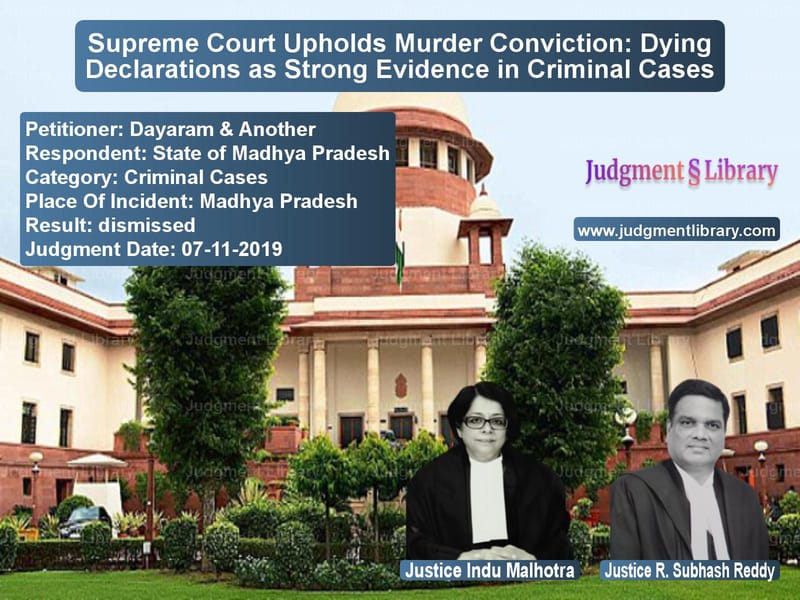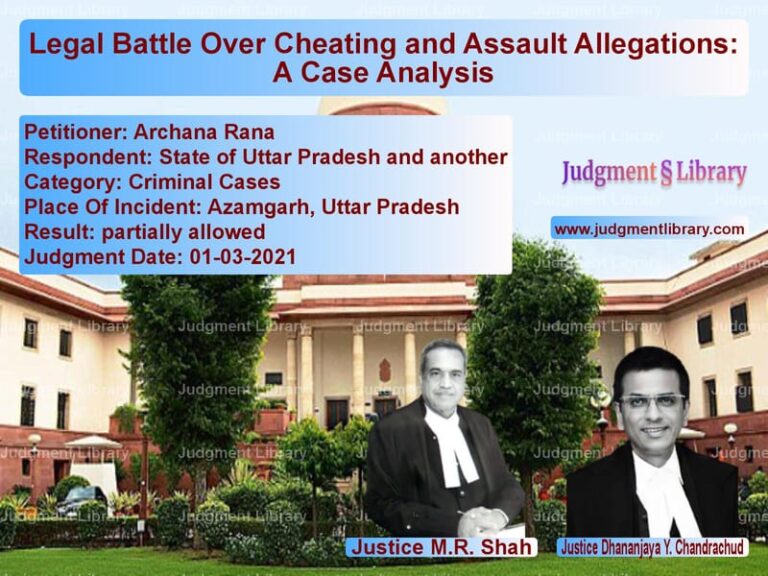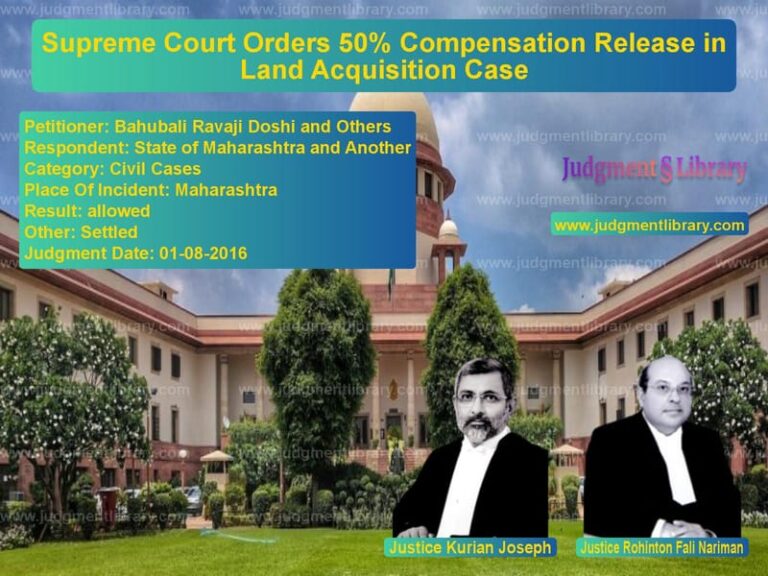Supreme Court Upholds Murder Conviction: Dying Declarations as Strong Evidence in Criminal Cases
On November 7, 2019, the Supreme Court of India delivered a landmark judgment in the case of Dayaram & Another vs. State of Madhya Pradesh, upholding the conviction of the accused under Section 302 of the Indian Penal Code (IPC). The case revolved around the brutal attack on a man named Ghansu, who succumbed to his injuries but managed to give two dying declarations. The Court reaffirmed that dying declarations, when consistent and supported by medical and corroborative evidence, serve as compelling evidence in criminal trials.
Background of the Case
The case originated from an incident that occurred on December 19, 1991, in Madhya Pradesh. The complainant, Ghansu, was allegedly attacked with lathis (wooden sticks) by the accused, Dayaram and Parsu Yadav. The assault took place near a canal while he was returning from the Ishanagar Police Station, where he had gone to file a complaint against one of the accused for beating his son, Chandu.
The attack left Ghansu severely injured and unconscious. Believing him to be dead, the accused threw him into the canal. However, Ghansu regained consciousness, managed to call for help, and was rescued by villagers who took him to the police station and then to a hospital.
Legal Proceedings
Ghansu provided two dying declarations—one at the police station and another before the Executive Magistrate at the hospital. Despite medical efforts, he succumbed to his injuries. The post-mortem report confirmed multiple grievous injuries, including skull fractures, which were consistent with a brutal assault.
Charges Against the Accused
- The accused were charged under Sections 341 (wrongful restraint), 323 (voluntarily causing hurt), 325 (grievous hurt), 307 (attempt to murder), and later Section 302 IPC (murder) following the victim’s death.
- The Sessions Court convicted both accused under Section 302 IPC and sentenced them to life imprisonment.
- The Madhya Pradesh High Court upheld the conviction and sentence.
Arguments Before the Supreme Court
Appellants’ Arguments
- The defense argued that the prosecution witnesses had turned hostile, making their testimonies unreliable.
- The second dying declaration did not bear the thumb impression of the deceased, making it legally questionable.
- The accused were falsely implicated due to pre-existing enmity.
Prosecution’s Arguments
- The first dying declaration, recorded in the FIR, bore the victim’s thumb impression, confirming its authenticity.
- The Executive Magistrate, who recorded the second dying declaration, confirmed that the victim was fully conscious.
- The post-mortem report corroborated the injuries described by the victim in both dying declarations.
- The chain of circumstantial evidence and medical reports proved the accused’s involvement beyond reasonable doubt.
Supreme Court’s Observations and Judgment
The Supreme Court extensively analyzed the evidentiary value of dying declarations and upheld their legal sanctity. Key observations included:
- The FIR lodged by the deceased was treated as the first dying declaration, which explicitly named the accused and provided details of the attack.
- The second dying declaration, recorded by the Executive Magistrate at the hospital, remained consistent with the first.
- The absence of a thumb impression on the second dying declaration was immaterial since the medical officer confirmed that the victim was physically incapable of providing one due to his injuries.
- The testimonies of medical officers and the Executive Magistrate established that the victim was in a conscious and fit state of mind while making the dying declarations.
- The minor contradictions in witness testimonies did not impact the prosecution’s case, as the core facts remained unshaken.
Relying on previous precedents such as Laxman vs. State of Maharashtra (2002) 6 SCC 710 and Dharam Pal vs. State of U.P. (2008) 17 SCC 337, the Court reiterated that a dying declaration is admissible in evidence if it is voluntary and truthful, even if uncorroborated, provided it inspires confidence.
The Supreme Court ruled:
“Considering the totality of the evidence including the two dying declarations made by the deceased, which are both consistent with each other and corroborated by medical and ocular evidence, we affirm the judgment passed by the Sessions Court and the High Court.”
Final Judgment
- The Supreme Court dismissed the appeal, upholding the conviction of the accused under Section 302 IPC.
- The life imprisonment sentence awarded by the Sessions Court and affirmed by the High Court was maintained.
Implications of the Judgment
This judgment serves as a crucial precedent for cases relying on dying declarations. The ruling establishes the following legal principles:
- Dying declarations hold strong evidentiary value if made voluntarily and in a fit mental state.
- Minor inconsistencies in witness testimonies do not weaken the prosecution’s case if core facts remain intact.
- A medical certificate confirming consciousness is sufficient to validate a dying declaration.
- Absence of a thumb impression on a dying declaration does not invalidate it if justified by medical reasons.
- Witnesses turning hostile does not automatically nullify their earlier statements.
Conclusion
The Supreme Court’s ruling in Dayaram & Another vs. State of Madhya Pradesh underscores the importance of dying declarations as valuable pieces of evidence in criminal trials. The judgment reaffirms that when properly recorded and corroborated, a dying declaration can form the sole basis for conviction. This ruling strengthens the legal framework for handling cases where the victim’s final words provide the key to justice.
Petitioner Name: Dayaram & Another.Respondent Name: State of Madhya Pradesh.Judgment By: Justice Indu Malhotra, Justice R. Subhash Reddy.Place Of Incident: Madhya Pradesh.Judgment Date: 07-11-2019.
Don’t miss out on the full details! Download the complete judgment in PDF format below and gain valuable insights instantly!
Download Judgment: Dayaram & Another vs State of Madhya Prad Supreme Court of India Judgment Dated 07-11-2019.pdf
Direct Downlaod Judgment: Direct downlaod this Judgment
See all petitions in Murder Cases
See all petitions in Bail and Anticipatory Bail
See all petitions in Attempt to Murder Cases
See all petitions in Judgment by Indu Malhotra
See all petitions in Judgment by R. Subhash Reddy
See all petitions in dismissed
See all petitions in supreme court of India judgments November 2019
See all petitions in 2019 judgments
See all posts in Criminal Cases Category
See all allowed petitions in Criminal Cases Category
See all Dismissed petitions in Criminal Cases Category
See all partially allowed petitions in Criminal Cases Category







